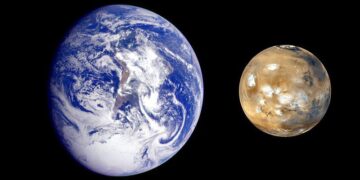Mars, often celebrated as Earth’s red neighbor in the cosmos, has long been the focus of studies related to space exploration and the search for extraterrestrial life. But recent research reveals a surprising twist in the story—Mars’ gravitational pull has a subtle yet significant influence on Earth’s climate, altering its orbit and impacting deep-sea currents over millions of years.
The Influence of Mars’ Gravity on Earth’s Orbit
Mars’ gravitational pull subtly alters Earth’s orbit every 2.4 million years, drawing it closer to the Sun and causing an increase in solar radiation. This phenomenon is known as an “astronomical grand cycle,” a result of gravitational resonance between the two planets. According to Dietmar Müller, a geophysics professor at the University of Sydney, “The gravity fields of planets interfere with each other, changing orbital eccentricity, a measure of how circular their orbits are.”
As Earth’s orbit becomes slightly more elliptical due to this interaction, the distance between our planet and the Sun decreases during certain phases. This results in warmer climates on Earth, marking the peak of the cycle. These subtle changes in Earth’s position relative to the Sun emphasize the interconnectedness of celestial mechanics and terrestrial phenomena.
How Gravitational Cycles Impact Earth’s Climate
The gravitational resonance between Mars and Earth doesn’t just affect orbital eccentricity—it has profound implications for Earth’s climate. During these cycles, increased solar radiation warms the planet, intensifying deep-sea currents. Research led by Adriana Dutkiewicz from the University of Sydney used satellite data to map sediment accumulation on the ocean floor over 65 million years, revealing gaps in the geological record that correspond to these warming periods.
These findings suggest that stronger ocean currents, fueled by Mars-induced warming, disrupt sediment deposition on the ocean floor. Such powerful currents play a critical role in global heat distribution, influencing climate patterns and sustaining ecosystems.
Deep-Sea Currents: The Unsung Climate Heroes
Deep-sea currents, often described as the “conveyor belts” of the ocean, are vital to Earth’s climate system. One key player is the Atlantic Meridional Overturning Circulation (AMOC), which transports warm water from the tropics to the Northern Hemisphere and returns cold water to the depths.
Mars’ gravitational influence appears to amplify these currents during warming cycles, ensuring the ocean remains dynamic even as sediment deposition is disrupted. Müller notes, “There are at least two separate mechanisms that contribute to the vigor of deep-water mixing in the oceans.” This interaction between celestial mechanics and oceanic systems underscores the importance of these currents in maintaining a stable climate, even in the face of potential disruptions like global warming.
Mars and the “Cosmic Dance” of Orbital Mechanics
To understand the influence of Mars on Earth’s climate, it’s essential to consider the broader context of orbital mechanics. Every planet in the solar system participates in a cosmic dance governed by gravity. Mars, with its elliptical orbit and close encounters with Earth every 26 months, exerts a subtle but measurable pull on our planet.
This gravitational interaction, while imperceptible in everyday life, accumulates over millions of years, creating cycles that influence everything from ocean currents to climate patterns.
The Role of Sediment Records in Decoding Climate History
One of the most fascinating aspects of this research is how geological evidence helps decode these long-term cycles. By analyzing sediment layers on the ocean floor, scientists can trace changes in deep-sea currents and correlate them with astronomical grand cycles.
The gaps in sediment deposition identified in the study align with periods of intensified ocean currents, driven by Mars-induced warming. These records act as a time capsule, preserving evidence of how Earth’s climate has responded to celestial influences over millions of years.
Implications for Future Climate Resilience
While the study focuses on natural cycles spanning millions of years, it offers valuable insights into the resilience of Earth’s climate systems. As modern climate change threatens critical ocean currents like the AMOC, understanding how these systems have adapted to past disruptions provides a glimmer of hope.
The mechanisms that sustain deep-sea circulation during Mars-induced warming cycles could offer clues for mitigating the effects of current climate challenges. By learning from Earth’s geological history, scientists can better predict how the planet might respond to future changes.
What We Can Learn from Mars’ Influence
This discovery highlights the importance of looking beyond Earth to understand its climate. The interplay between Mars and Earth serves as a reminder of the dynamic forces shaping our planet, both from within and beyond.
It also raises intriguing questions about the potential for similar interactions on other planets. Could gravitational resonance between exoplanets influence their climates and habitability? These questions open new avenues for research, bridging planetary science and astrobiology.
Conclusion
The revelation that Mars’ gravitational pull influences Earth’s orbit, climate, and ocean currents is a testament to the intricate connections that define our solar system. This cosmic interplay, spanning millions of years, underscores the profound impact of celestial mechanics on terrestrial systems.
Reference:
Deep-sea hiatus record reveals orbital pacing by 2.4 Myr eccentricity grand cycles



















